
Who will find this article useful?
- Founders of modern companies looking for a VP of Sales to manage their growing sales system because they can’t manage it themselves anymore
- Founders of modern companies whose last VP Sales hire didn’t work out
Index of this article
In Part 1 of this article, we have shared our point-of-view about:
- Context Setting
- What work do VP Sales do
- Who to look for. Who not to look for
In Part 2, which we will post later, we will cover –
- Where to look. Where not to look
- How to woo them
- How to evaluate them. How not to evaluate them
- How to make an offer
- How to induct them into the organization
It is based on the context we’ve set below.
1. Context Setting
For better understanding, let us set the context once again like we did in another article we wrote some time ago about sales problems CEOs of growth stage companies face.
Context: We started working on sales design related stuff just over a year ago. Since then, we’ve met ~ 90 CEOs / COOs / VP Sales of early and mid-stage companies to understand their go-to-market challenges. Most of these companies are backed up by reputed investors so we’re talking about serious bets on the future here. A large number of them were at a stage of growth where they needed an experienced VP Sales to manage their sales system — it had clearly gone beyond the control of the founders and they were aware that they needed an ‘expert’ to take over.
We also speak to candidates who are looking for a VP Sales role and they tell us their interview experiences. That adds to our research database.
Of course, our point of view is also coloured a bit with our personal experiences but we’re sharing it anyway.
CEO persona: Let us paint a picture of the most common persona we met. Think of this CEO / COO as a young (25–35 yr), ambitious person who is the brains behind the concept and the product but doesn’t necessarily code. She has a co-founder in the same age bracket who usually looks after sales. Both have worked in one organization before they founded the company and none of them has worked in sales before. The CEO has bootstrapped her way through the initial phase and then picked up some funding. Her network within the investor community is quite good. She’s aware of pretty much every book start-up CEOs are advised to read by pundits — most of them around product development and leadership. While she’s looking after one function for ~ 40% of her time, she wishes she had more hands to take care of all the stuff thrown at her by sales, marketing, finance, HR, admin and those endless requests for “2 min chats” with any team member not happy with something.
Business Model: Mostly aggregators, SaaS, media with modern, digital products. Most of them selling on a subscription model.
Sales Model: Mostly B2B, few B2C. Mostly selling to SMEs. Another chunk too large enterprises.
2. What work do VP Sales do
This part is a long read- for those who have worked with a lot of VP Sales, you can skip to section 3.
There’s a gamut of activities that VP Sales do. And it’s tough to enumerate them completely. So let us try and explain it by making a map of the stakeholders they interact with. Hopefully, it’ll help you imagine it in your head easily.
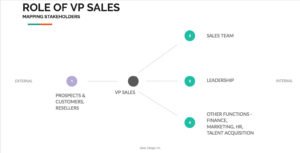
Individual Contribution towards Prospects & Customers, Resellers
This is the part where the VP Sales executes the go-to-market plan directly as an individual contributor. Let me break it down further, again in terms of stakeholders.
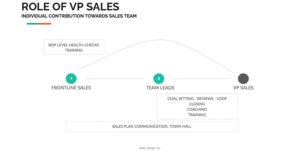
Sales Development Initiatives involve improving lead flow at the top of the sales funnel.
Customer Insights involve gathering aggregated customer data around product usage, pricing, churn, etc, identifying challenges & opportunities and solving them, not one-by-one, but with some system-level initiative.
Partnership Development Initiatives involve understanding aggregated information and data around reseller’s go-to-market challenges and solving them, not one-by-one, but with some system-level initiative. Resellers are rare in growth-stage companies though.
Individual Contribution towards Sales Team
This is the part where the VP Sales manages a sales team. Let me break it down further, again in terms of stakeholders.
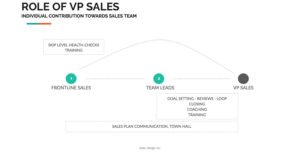
With Team Leads, the VP Sales’ role doing the hygiene drill of goal setting-reviews-loop closing on goals and training them on the technical aspects of their role. Apart from this, it the VP Sales’ role to coach the Team Leaders and help them think through the challenges and opportunities that lay in front of them.
With Frontline Sales, the VP Sales’ role is to run Skip-level health checks. These checks could be regarding their motivation levels and to check whether sales plan communication has been understood well by the frontline. If Team Leads are the maker, VP Sales is the checker. If the VP Sales also conducts progress reviews with frontline sales, just like their team leaders, it can be potentially fatal for the sales culture.
With the entire Sales Team, the VP Sales’ role is to communicate the sales plan and conduct town halls which cover rewards & recognition, important communication regarding a product, org changes, etc. Delegating sales plan communication to Team Leaders usually (greatly) reduces its effectiveness.
Individual Contribution towards Leadership
There are three buckets of activities that the VP Sales usually does with the Leadership.
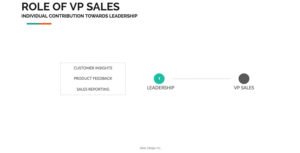
Customer Insights involve solving the challenges and exploiting the opportunities found by studying aggregated customer data around product usage, pricing, churn, etc, with some system-level initiative. These are usually done in consultation with the Leadership.
Product Feedback involves gathering the voice of the customer about the product and relaying it back to the leadership team. Remember, we are talking about growth-stage companies and the product is still evolving.
Sales Reporting involves… well, we all know what it involves. Apart from progress reporting, it also involves reporting derived metrics around Sales Pipelines, Sales cycles, ARPA (Average Revenue per Account), Salesforce productivity, etc. Here’s a fairly exhaustive list by RAIN Group on metrics you can track for your business.
Individual Contribution towards other functions
Marketing, Finance, HR and Talent Acquisition are the four functions with which VP Sales interacts most often. We’ve mentioned Talent Acquisition separately from HR because in growth stages, this function can take up an inordinately high amount of the VP’s time.
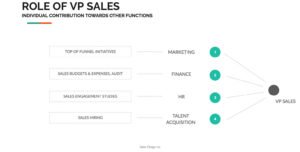
Marketing and Sales, the siamese-twins, have to go hand in hand. Here, the VP Sales has to ensure that the marketing folks are targeting the right customer segment and enough of them to fill the top of funnel. A continuous feedback loop must be running back from sales to marketing and vice versa and fine-tune the top of funnel initiatives. The VP Sales along with the VP Marketing are the custodians of this loop.
Finance is the function that keeps a track of sales expenses, budgets and most importantly, payment collections and outstanding payments. The VP Sales must have an understanding of basic finance and accounts to ensure that the finance folks are able to do their job well. More importantly, the VP Sales is an important stakeholder when it comes to an annual financial Audit. Its not uncommon for the VP Sales to be interviewed by the auditors and the VP Sales must be prepared for that.
HR and VP Sales can cooperate well to co-design and run Sales Engagement Audits. This initiative can provide very good feedback to the VP Sales about engagement levels in their team, training and upskilling levels.
Talent Acquisition and VP Sales teamwork is key to hiring success. Job Description design, fixing compensation, candidate personas, sales assessments, interviewing and Onboarding — rarely are any of these done in isolation by Talent Acquisition. The VP Sales has a fairly good sense of the above and can contribute substantially in defining benchmarks for the above activities.
This information about the role of a VP Sales can help you in identifying the areas you want to evaluate while hiring.
In case you are aspiring to become a VP Sales, hopefully, this framework can help you develop these skills.
3. Who to look for. Who not to look for
This is usually an intense discussion between co-founders when they decide to hire a VP Sales — what qualities do we look for? Again, very difficult to enumerate all qualities. But there are a few trends which we’ve spotted that can’t be ignored—
- High failure rate of “performance” hires from traditional set-ups. If you want to read more about performance and potential hires, here’s a good introductory article.
- High failure rate of “cowboys”
Let us explain.
High failure rate of “performance” hires from traditional set-ups
Mostly, VP Sales who’ve done this job before in modern organizations aren’t looking to do it again. They are looking for a newer challenge. Maybe a role shift, a larger geography or a global product. That reduces the top of your hiring funnel substantially.
The ones who’ve done a similar role in a more traditional set-up are looking out for such opportunities. There’s a large bunch of people who don’t want to miss out on the VC funded start-up revolution despite the risks. Unfortunately, the new ecosystem is a bit too much to take for them. “Start-up culture”, a modern product, a younger boss — if you check any of these boxes, watch out. When we met founders of companies, such stories are rife. Its not long before one of them calls it off.
What went wrong? Expectation mismatch. Founders expect such VP Sales to hit the ground running. In spite of their good intentions, the truth remains that a young founder is unlikely to have time to handhold the VP Sales through the first few critical months of their journey. The struggle begins when the VP Sales is left on her own to figure her way out within the new, relatively chaotic set-up. Eventually, this rarely works out well and we found enough evidence to support it in the last one year.
High failure rate of “cowboys”
Who are cowboys? This is an archetype of VP Sales who are experts at keeping a sales team on their toes and making them run faster. That’s great. Its a much needed skill. Unfortunately, that’s about it. You call her into the board room to discuss a new product, new pricing strategy, a new communication, a new tactic and you’ll find her looking completely lost. They rarely have an opinion of their own on a new strategy or plan and usually struggle to deal with ambiguity that surrounds it.
Its not their fault. Cowboys are usually the “performance” hires from another traditional set-up who somehow made it through the initial stages despite lack of handholding. And they do well at what they’ve done well in the past — cowboying sales reps. But it is rare to find someone who’s dealt with the ambiguities that hit a VP Sales in a growth stage company where product, pricing, sales plans change every quarter, if not every month. It was evident when we heard stories from many founders on this subject.
Hiring a VP Sales is not a simple make or buy choice any more. Its a buy-then-make deal.
Buy-then-make your “potential” hire
Which automatically means you are going for a “potential” hire. “Buy” what you can’t teach in the short term — look for the “must have” skills at the time of hiring. Train them on the good to haves after hiring — make.
That brings us to the question — What should you “buy”? And what should you “make”?
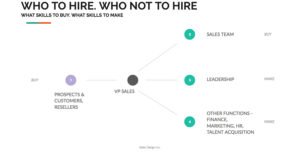
There’s a clear pattern that emerged in our interaction with founders. The ones who the highest tenure and successful VP Sales were the ones who had some prior experience in the following interactions:
- Interactions with Prospects & Customers — they had performed an individual contribution role at some stage of their careers in a customer facing role
- Interacting with a Sales Team — they had led a small team of sales reps
It made sense. It takes years to develop proficiency in sales. And at least half that time to learn the basics of leading a team. Very difficult to train someone on this in the short term.
They had no prior experience in:
- Interactions with Leadership
- Interactions with other functions
We found that the founders were actively engaged in handholding them with the latter. Imagine a 5–7 years experienced sales leader who has lead small sales teams in the past being groomed by either the founder or an external mentor / coach for the VP Sales role. It is possible to train / coach a sales leader on these. The cost of any mistakes in these departments are totally dependent on the tolerance level of the founders. In these cases, the founders were very tolerant and fully committed to making the VP Sales succeed.
_________
In Part 2 of this article, we will write about:
- Where to look. Where not to look
- How to woo them
- How to evaluate them. How not to evaluate them
- How to make an offer
- How to induct them into the organization
________
This article is co-authored with Ninad Tawade, Co-Founder, Sales Design Inc. It is a reflection of our personal experiences as well as research from the past one year of our experience as Sales Designers. If you have any queries on this article, please write to saurabh@salesdesign.co.in

If you need our help in Sales Development, please write back to me at saurabh@salesdesign.co.in
For more information B2B Lead Generation Get in touch



